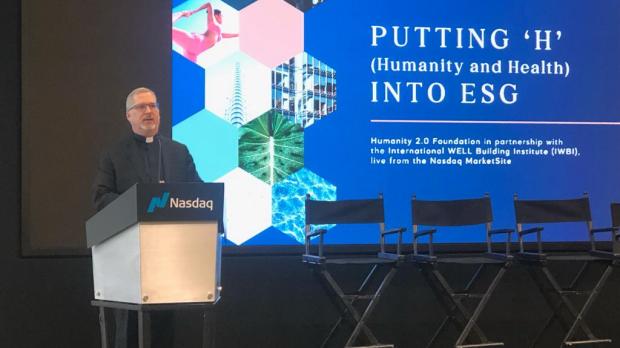On Feb. 28, Fr. Philip Larrey chaired a forum discussion, live from the NASDAQ Marketsite, titled “Putting ‘H’ (Humanity and Health) Into Environmental, Social and Corporate governance.” Fr. Larrey is the Dean of the Philosophy department of the Pontifical Lateran University (Rome) and Chairman of Humanity 2.0, a not-for-profit focused on bringing actors together to promote human flourishing and the aims of Laudato Si’. Fr. Larrey spoke to Aleteia about how the Church can help other actors improve human well-being and his projects to advance this goal at the Vatican.
What is the forum discussion at NASDAQ about?
The event at NASDAQ Marketsite teams up Humanity 2.0 and the International WELL Building Institute. One of the co-founders of Humanity 2.0, Morad Fareed, is also a co-founder of Delos, a company focused on building standards. There is a subset of Delos called the international WELL Building Institute, which is trying to use science-based information in order to help us build better buildings. 90% of our day is spent inside, so they want to understand how buildings affect human beings and how we can make them more suitable to us.
They look at things such air filtration, natural lighting, the color of the paint on the walls, the spaces in corridors, how communication is achieved during the work hours or in the building, etc. They came up with the WELL Building Standard, a certification which provides evidence that the building allows human beings to flourish. Some examples of certified buildings are the Empire State Building and the Yankee Stadium in New York City, or the Googleplex headquarters in Mountain View, California. They are now helping us to achieve this certification for the Pontifical Lateran University.
What is Humanity 2.0?
Humanity 2.0 is a non-profit foundation founded in 2018, whose main purpose is to identify and overcome or eliminate obstacles to human flourishing. We understand flourishing as creating an environment where human beings can achieve their goals of self-realization. We’re looking at human flourishing as a new way of indicating the wealth of a nation, it’s no longer just about gross national product or economic development. There are different organizations in the world, which we work with, that are trying to quantify what human flourishing means, such as the Human Flourishing Program at Harvard University.
One of the things that I am very proud of doing at Humanity 2.0 is making worlds that don’t usually meet, speak to each other. We create an environment in which actors or businesses that never engage with the Vatican or with the Church, can realize the value that we bring to issues. Every year Humanity 2.0 organizes a forum at the Vatican to bring together business leaders, academics and people involved in politics or social policy, to try and talk about important questions, so we can advance the agenda of Laudato Si’, or what we are now calling human flourishing. We haven’t been able to organize it for the last two years due to the pandemic but it will be happening this coming May.
What unique perspective can Catholics or the Church bring to the issues concerning the well-being of people or the environment ?
Catholic social doctrine. The richness of Catholic philosophical tradition, for example, can shed an incredible light to issues that are being debated right now in the technological field such as artificial intelligence or robots. The issues coming out of Silicon Valley are vital and Catholic philosophical tradition is a good way of framing them. People in Silicon Valley are asking themselves what is the relationship between the body and the soul or is there an afterlife, and they have never considered a Catholic point of view. So I suggest, why not look at Thomas Aquinas, or Augustine. We try and translate the language that engineers are using into what Catholic tradition can offer.
Why are you trying to implement the WELL Building Standard at the Pontifical Lateran University?
It is a way in which we can fulfill Pope Francis’ ideas in Laudato Si’. He doesn’t use the words “human flourishing,” but when he talks about the care for creation I think we can understand it in the same sense. Laudato Si’ is about decreasing the impact of economic progress on our ecology and about climate change and care for the earth, but it’s also about how we can help people achieve their goals in a better way and create an environment in which people can flourish and be healthy. It is important to build something that is conducive to human interactivity and to fostering relationships amongst ourselves. When people flourish they can also do their jobs better.
Many people who don’t usually associate with the Catholic Church have read Laudato Si’ or found out about its principles and have become very interested. We would like to renew that interest and keep encouraging it.
How has the process of certifying the University been going so far?
With a dedicated committee, we have been tackling this for about 7 months now, and it is quite a meticulous process. We have just upgraded our air filtration system, for example.
Another example is the smoking area. In order to achieve this certification the building has to be smoke-free. Obviously smoking inside is prohibited and has been for many years; at the University you can only smoke outside. However, the standard provides that the smoking area should be at least 10 meters away from the doors, otherwise it is almost as if you are smoking in the building.
The entire complex of the University is being scrutinized, inch by inch, as the WELL Building Standard is very demanding. I hope we achieve the certification within this year.
Are there any other Vatican buildings that have gone through this process ?
The Pontifical Oriental Institute, lead by the rector, Fr. David Nazar, has also been renovating several of its spaces under the WELL Building Standard. For example, one thing they looked at in classrooms was the effect of echos. They found that when a professor was speaking the students would listen to him with a two-second delay due to the echo and the acoustics of the room. They were able to bring that down to zero through works in how the classroom was constructed. He found that productivity increased for students and professors and that their experience in the classroom was much better than before.
What could a future collaboration between WELL Building Standard and the Vatican look like?
Every building in the Vatican should be certified, that’s the goal. We’re taking baby steps for now though. The Pontifical Lateran University will probably be the first to be fully certified. Cardinal Czerny though, for example, also showed interest in the idea. It’s an ambitious goal but we want to try and do, for the entire Vatican, what Pope Francis hopes and expresses in Laudato Si’.




